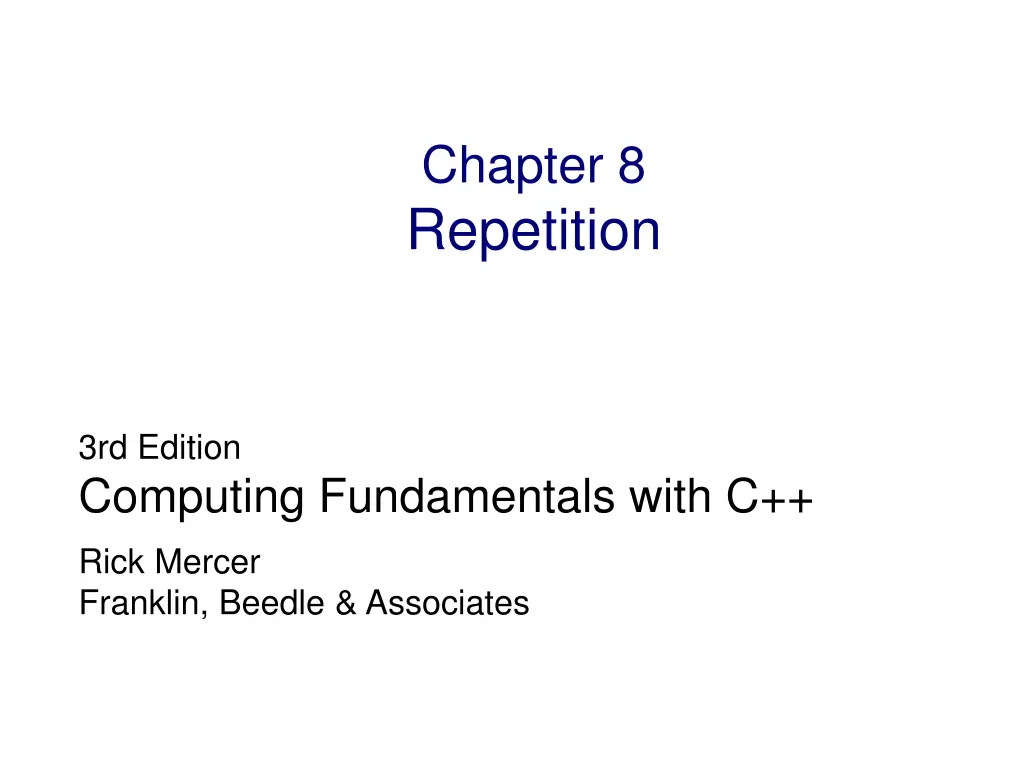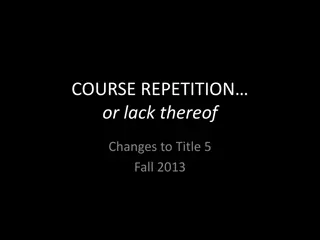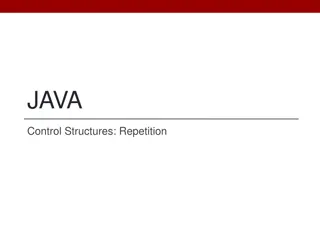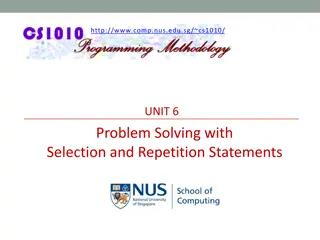
Understanding Repetitive Control Algorithms in Computing Fundamentals with C++
Explore the concepts of determinate and indeterminate loops in C++, understand the need for repetition in programming, and learn how to implement loops efficiently for various tasks. Discover the advantages of leveraging computer speed and avoiding repetitive code to enhance program efficiency and scalability.
Download Presentation

Please find below an Image/Link to download the presentation.
The content on the website is provided AS IS for your information and personal use only. It may not be sold, licensed, or shared on other websites without obtaining consent from the author. If you encounter any issues during the download, it is possible that the publisher has removed the file from their server.
You are allowed to download the files provided on this website for personal or commercial use, subject to the condition that they are used lawfully. All files are the property of their respective owners.
The content on the website is provided AS IS for your information and personal use only. It may not be sold, licensed, or shared on other websites without obtaining consent from the author.
E N D
Presentation Transcript
Chapter 8 Repetition 3rd Edition Computing Fundamentals with C++ Rick Mercer Franklin, Beedle & Associates
Goals Use the Determinate Loop pattern to execute a set of statements a predetermined number of times Implement determinate loops with the for statement Recognize and use the Indeterminate Loop pattern to execute a set of statements until some event occurs to stop it (no more data, for example) Implement indeterminate loops with the C++ while statement
Repetitive Control The following algorithms involve repetition Add the remaining flour cup at a time whipping until smooth While there are more burger/fries/soda orders, sum each item. Apply tax. Display Total. Compute a course grade for every student While the ATM is running, process another customer, and allow many transactions Microwave the food until the timer reaches 0, the cancel button is hit, or the door is opened
Why is repetition needed? To take advantage of the computer's speed to perform the same tasks faster To avoid writing the same statements over and over again (shorter programs) To visit all elements in a collection of objects To make programs general enough to handle various sized collections of data Consider code intended to average exactly 100 numbers (next slide):
Crazy way to average 100 values double number; double sum = 0; cout << "Enter number: "; // <-Repeat these three cin >> number; // <- statements for each sum = sum + number; // <- number in the set cout << "Enter number: "; cin >> number; sum = sum + number; // ...291 statements deleted ... How many statements are required for 100 inputs?____ cout << "Enter number: "; cin >> number; sum = sum + number; double average = sum / 100; cout << "Average: " << average << endl; What changes are necessary to average 200 inputs? ____
The Determinate Loop Pattern There is a better way We often need to perform some action a specific number of times: Produce 89 paychecks Count down to 0 (take 1 second of the clock) Send grade reports to 75,531 students The Determinate Loop pattern repeats some action a specific number of times
Pattern:? Determinate Loop Problem:? Do something exactly n times, where n is known in advance. Algorithm? determine n repeat the following n times { perform these actions } Code? Example:? for (int count = 1; count <= n; count++) { cout << "Enter number: "; // Repeat cin >> number; // these sum = sum + number; // statements } cout << "Enter n: "; cin >> n;
Determinate Loops This template repeats a process n times n =how often we must repeat the process for (int i = 1; i <= n; i = i + 1) { the process to be repeated } Determinate Loops must know the number of repetitions before they begin Know exactly how many employees, or students, or whatever, that must be processed
The for loop for (initial statement;loop-test;update-step) { repeated-part } When a for loop is encountered the initial-statement is executed, usually int i = 0; The initial-statement is only executed once, when the loop is entered the loop-test evaluates to true or false if the loop-test is false, the for loop is terminated if loop-test is true, the repeated-part is executed and the update-step executes
Flow Chart View of a for loop Initial statement true false Loop test Repeated Part update-step
Use a for loop to produce an average int n; double number; double sum = 0.0; // Get a value for the number of iterations cout << "How many numbers? "; cin >> n; for(int count = 1; count <= n; count = count + 1) { // Repeat the same three statements n times cout << "Enter number: "; cin >> number; sum = sum + number; } // Compute and display the average double average = sum / n; cout << "Average: " << average;
Operators ++ and -- It is common to see determinate loops of this form where n is the number of repetitions for(int count = 1; count <= n; count++) The unary ++ and -- operators add 1 and subtract 1 from the values, respectively int n = 0; n++; // n is now 1, equivalent to n=n+1; n++; // n is now 2 n--; // n is now 1 The expression count++; is equivalent to the more verbose count = count + 1;
Other Assignment Operators C++ has several assignment operators in addition to= n -= 2; is the equivalent ofn = n - 2; sum += x; is the equivalent of sum = sum + x; What is sum when a user enters 7 and 8? int sum = 0; int num = 0; cout << "Enter a number: "; cin >> num; // user enters 7 sum += num; cout << "Enter a number: "; cin >> num; // user enters 8 sum += num;
Determinate Loops with Grid Object This code surrounds the Grid with blocks Grid g(7, 14, 4, 4, east); g.display(); for (int row = 0; row < g.nRows(); row++) { g.block(row, 0); // block west col g.block(row, g.nColumns() - 1); // block east col } for (int col = 1; col < g.nColumns() - 1; col++) { g.block(0, col); // block north row g.block(g.nRows() - 1, col); // block south row } The Grid: # # # # # # # # # # # # # . . . . . . . . . . # # . . . . > . . . . . # # . . . . . . . . . . # # # # # # # # # # # # # g.display();
The Determinate Loop Pattern Find the Range of Test Scores Find the range of test scores where range is defined as the highest minus the lowest With the input of 4 test scores 80, 70, 100, and 90, what is the range _____? Prelude to the range problem: Imagine finding the largest number in a list of thousands of numbers we need a systematic method (we can t just glance at the list)
Analysis Problem: Write a program that determines a range (highest-lowest) of test scores. The user must enter the number of tests to check Inputs: The number of test scores to scan, and the actual test scores Output: The range Name the objects? _________ _________ _______ _______
Design Start with this algorithm 1. Obtain the number of test scores 2. Determine the range 3. Display the range You might notice that the process step, "Determine the range", needs further refinement The first step is a prompt/input pattern and the third step is simply labeled output
Design (an Algorithm) 1. Obtain the number of test scores cout << "Enter number of test scores: "; cin >> n; 2. Determine the range: TBA 3. Display the range cout << "Range = " << range; Let us concentrate on the second step: Determine the range Since range is defined as largest smallest, we need to find the largest and smallest
Design We need the actual test scores for input to determine the largest and smallest As each new test score is input, we compare it to the highest so far, and also to the smallest so far But what do we compare the first test to? How about something very large for the smallest 1,000 will be the smallest so far and something very small for the largest -1,000 will be the largest so far Then the first number (we'll use 76) is compared to these artificial values for largest and smallest
Design continued In a side by side comparison, we see a valid test score (76) is greater than the largest so far (-1000) and also less than the smallest so far (+1000) 1000 smallest +1,000 test 76 500 largest -1,000 0 -500 -1000
Design Before reading tests from the user, initialize largest and smallest like this: double largest = -1000; double smallest = +1000; Then we need to do the following n times 1) Input a test 2) Compare test to largest and if necessary, store the test as the largest 3) Compare to smallest and if necessary store it as the smallest Trace with inputs of 87, 91, 72 (range 91-72=19) test largest smallest +1000 ? -1000 87 87 87 91 91 87 72 91 72
Implementation int n = 3; int test; int largest = -1000; int smallest = 1000; // 2. Determine the range for (int counter = 1; counter <= n; counter++) { // The process to repeat n times cout << "Enter test: "; cin >> test; if (test > largest) largest = test; if (test < smallest) smallest = test; } int range = largest - smallest; cout << range; Dialog Enter test: 87 Enter test: 91 Enter test: 72 19
Why bother? It should be noted, that this computer based range problem is more cumbersome than just scanning a small list of tests for the highest and lowest But imagine thousands of value stored in a file or a spreadsheet We could use the same pattern, but someone must somehow count the inputs before starting There must be a way to do this programmatically
Algorithmic Pattern The Indeterminate Loop Determinate loops have a limitation We must know n in advance Many situations repeat a set of statements, but we can not determine how many: Processing report cards for every student in a school (or paychecks for all employees, or...) Generating a bill for every customer Playing a game until somebody wins
Some Events that terminate indeterminate loops An indeterminate loop repeats a process until some stopping event terminates the repetition There are many such events, but we'll focus on these events only: User enters a special value indicating end of data. A logical expression becomes false The Grid mover hits the wall or an edge The end of a file is encountered Indeterminate loops do not need to know n in advance
Pattern: Indeterminate loop Problem: Some process must repeat an unknown number of times so some event is needed to terminate the loop. Algorithm: while(the termination event has not occurred) { perform these actions bring the loop closer to termination somehow } Code Code Example: Example:myGrid.putDown(); myGrid.move(); } while(aGrid.frontIsClear()) {
The while loop The indeterminate loop pattern can be implemented with the C++ while loop while (loop-test) { repeated-part } When a while statement is encountered the block executes while (as long as) the loop-test is true You need to determine the loop test, an expression that must eventually become false
Flow chart view of while-loop execution false true loop-test statement-1 Iterative Part statement-2 statement-n
while Statement as a Determinate Loop This loop terminates when counter <= n becomes false The event that terminates this loop is counter > n int counter = 1; int n = 4; while (counter <= n) { cout << counter << " "; counter++; } Output? ______________
Indeterminate Loop Pattern with Grid Grid g(5, 10); // assert: g is a 5x10 Grid surrounded by blocks // with one opening and the mover in a random spot while (g.frontIsClear()) { g.move(1); } g.display(); Output # # # # # # # # # # # . . . . . . . . # # < . # . . . . . . . . # # # # # # # # # # #
Indeterminate Loop Using a Sentinel A sentinel is a specific input from the user or a signal that there is no more data The sentinel must be the same type of data The sentinel must not be in the valid range of data Example: Use -1 as the sentinel for test scores that can only be in the range of 0 through 100 Enter test scores or -1 to quit: 80 95 76 82 56 100 45 86 -1 A priming read could be used The first input could be -1 or a valid number The while loop test will check (see next slide)
Priming Read Read before the loop and at the end! int sum = 0; int test; cout << "Enter data or -1 to quit" << endl; cin >> test; while (test != -1) { sum += test; cin >> test; } cout << sum; Enter data or -1 to quit 1 2 3 -1 6 Dialog
Usingcin >>as a Loop Test An input with cin evaluates to true or false while (cin >> intObject) It can be part of the loop test to simplify the code // Reading input can be part of a loop test while ((cin >> test) && (test != -1)) { // Must have a valid int not equal to -1 sum += test; n++; // n is count of test }
Infinite Loops Infinite loop: a loop that never terminates Infinite loops are usually not desirable Below is an example of an infinite loop, there is no step that brings the loop closer to termination Wait until you hear your fan turn on, or better yet, terminate the program cin >> test; while (test != -1) { sum += test; n++; }
The do while Statement C++ also has a "post-test" loop The loop test occurs at the end of the loop Use when you have to do something to initialize part of the loop test (or use while with break) do { repeated-part } while (loop-test ) ; The repeated part always executes at least once a while loop executes zero times if the loop test is false immediately
Flow chart view of do while statement-1 Repeated Part statement-2 True statement-n loop-test False
Why another loop? char nextOption() { // post: return an uppercase W, D, or Q char option = '?'; do { cout << "W)ithdraw, D)eposit, or Q)uit: "; cin >> option; // wants w, W, d, D, q, or Q option = toupper(option); // need option in test } while( (option != 'W') && // a post test loop (option != 'D') && (option != 'Q')); return option; } Dialog: W)ithdraw, D)eposit, or Q)uit: x W)ithdraw, D)eposit, or Q)uit: y W)ithdraw, D)eposit, or Q)uit: z W)ithdraw, D)eposit, or Q)uit: w W int main() { cout << nextOption(); return 0; }
Equivalent while loop The while loop repeats until the user enters an upper or lower case W, D, or Q using break to exit the loop char nextOption() { // post: return an uppercase W, D, or Q char option; while (true) { cout << "W)ithdraw, D)eposit, or Q)uit: "; cin >> option; option = toupper(option); if (option=='W' || option=='D' || option=='Q') break; // a more positive way to stop } return option; }
Loop Selection and Design The following outline is offered to help you choose and design loops in a variety of situations: Determine which type of loop to use Determine the loop-test Write the statements to be repeated Bring the loop one step closer to termination Initialize objects if necessary
Determine Which Type of Loop to Use If the number of repetitions is known in advance or read as input, use a determinate for loop If the loop must stop when some event occurs, use an indeterminate while loop When the loop must always execute once (to validate input for example), use a do-while loop
Determine the Loop Test Try writing the conditions that must be true for the loop to terminate inputName == "QUIT" // Termination condition The logical negation (with ! applied) can be used directly as the loop-test of a while loop: while ( inputName != "QUIT") // logical negation
Write the Statements to be Repeated This is why the loop is being written { cout << "Enter number: "; cin >> x; sum = sum + x; n++; }
Bring the Loop one Step Closer to Termination To avoid an infinite loop, there should be at least one action in the loop body that brings it closer to termination. Increment the counter by +1 Read data from an input stream with cin >>
Initialize Objects if Necessary Check to see if any objects used in either the body of the loop or the loop-test need to be initialized In this loop, which object(s) need to be initialized before this while loop is encountered? _________ int count, n; double x, sum; while (count <= n) { cout << "Enter a number: "; cin >> x; sum = sum + x; count++; }






















